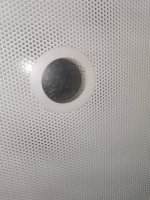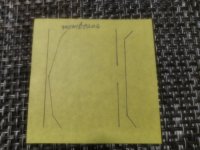well i increased output on ym panel, else it would not be fair. today i made a wider dual foil....And if you play at same level and then measure distortion.... how will it look like?
clocks in at 40cmx60cm including the frame
and here is a distortion measurement, i increased my panel in volume to match the LRS. but well i dont think its a match if i may say so.
Pic 2 Distortion LRS right side
Pic 3 Distortion Panel 3 dual foil (with EQ to get rid of the resonance for now) without it my whole room rattles. because its +12 dB on 44 hz or something haha.
so far i still am not able to hit the magnets... so i think i need to decrease the Xmax at least 1 mm. to gain some efficiency hopefully, and i might need to look into adding metal on the outer magnets to get them closer to the foil? and i might need to find a way to damp them without DSP. maybe i can play with the hole sizes between magnets and even add a chambfer ? might reduce som distortion problems i dont no. as for now im not sure if the speakers wants more open area or less... chambfer would decrease oven area between the panels.. i also dont know what reducing the air in between the foils does so with an xmax of 5 the air in bewteen the foils is reduced to, maybe less spring like ?
Last edited:
i tried some ribbon kind of foils... yes you can get resonance down, but it will flap all over the place.. so next up will be this design. idea would be restricting movement in the middle while giving the upper and bottom end a bit more movement by making the foil wider and more open area compared to the middle... who knows... pure gamble..

Last edited:
i think i did the other way around  i want to limit the middle, and give the top and bot more flexibility to move
i want to limit the middle, and give the top and bot more flexibility to move  (with might work due to the resoance been lower top and bot, but all the air pushed towards the other foil will be nicely distributed over the entire foil.. and then it will move where it can the most easy.. normally that was the middle.. hopefully now the top and bot)
(with might work due to the resoance been lower top and bot, but all the air pushed towards the other foil will be nicely distributed over the entire foil.. and then it will move where it can the most easy.. normally that was the middle.. hopefully now the top and bot)
since top and bot are more limited since it has 3 spacer holding the foil compared to only 2 and one side having really low res in the middle. but i guess in your case where the hole is its not driven hmm i might remove 2 of the middle magnets when i think of it
hmm i might remove 2 of the middle magnets when i think of it
since top and bot are more limited since it has 3 spacer holding the foil compared to only 2 and one side having really low res in the middle. but i guess in your case where the hole is its not driven
Last edited:
i think this is only true for ESL , since a hole would make it more easy to move there.  since it has less damping, and its not driven by a stator.
since it has less damping, and its not driven by a stator.
the reason why it would be easy to move there is because its just like a drum, and its the easiest to move in the middle of the circle.
i tried using damping in the middle only but it sounds weird. and not nice. and i think because both membranes share the volume in between.
i also tried a leaky contraption see how that goes.. and well as expected it lower resonance, but overall its worse. so i might need to add a gasket between the frame holding the foil and the wood that holds all the magnets. to make sure one foil drives also the other by the means of air.
the reason why it would be easy to move there is because its just like a drum, and its the easiest to move in the middle of the circle.
i tried using damping in the middle only but it sounds weird. and not nice. and i think because both membranes share the volume in between.
i also tried a leaky contraption see how that goes.. and well as expected it lower resonance, but overall its worse. so i might need to add a gasket between the frame holding the foil and the wood that holds all the magnets. to make sure one foil drives also the other by the means of air.
Last edited:
Havun's implementation has a more important advantage (only at static's): the centre of membrane is vulnerable by charge migration because there is the largest excursion. The undriven area of membrane reduces the excursion, and totally eliminates the charge migration (because there is "statorless").
The earlier Magnepans have doubled wire around the perimeter of their membranes, simple wire at centre. Another constructions work with bigger magnet-membrane distance at centre (most of them are push-pull, and the insufficient rigidity of magnet-frame provides the arcs ).
).
The earlier Magnepans have doubled wire around the perimeter of their membranes, simple wire at centre. Another constructions work with bigger magnet-membrane distance at centre (most of them are push-pull, and the insufficient rigidity of magnet-frame provides the arcs
I turned to the knowledge of a primitive man, he, imitating thunder, beat the center of a large drum with a mallet, this man then knew that the greatest amplitude of the leather membrane is in the center .
.
By the way, there were no electrostatics or magnetpanes then.
But it’s one thing to reproduce only a drum, and another to reproduce the entire range of low-frequency musical instruments, and in the case of our devices, be it magnets and glued-on coils or electrostatics, this position (where the center of the membrane is attracted more) can cause large distortions of the musical signal.
By the way, there were no electrostatics or magnetpanes then.
But it’s one thing to reproduce only a drum, and another to reproduce the entire range of low-frequency musical instruments, and in the case of our devices, be it magnets and glued-on coils or electrostatics, this position (where the center of the membrane is attracted more) can cause large distortions of the musical signal.
hehe yeah with PP its often a welcome effect of not strong enough frames hehe.Havun's implementation has a more important advantage (only at static's): the centre of membrane is vulnerable by charge migration because there is the largest excursion. The undriven area of membrane reduces the excursion, and totally eliminates the charge migration (because there is "statorless").
The earlier Magnepans have doubled wire around the perimeter of their membranes, simple wire at centre. Another constructions work with bigger magnet-membrane distance at centre (most of them are push-pull, and the insufficient rigidity of magnet-frame provides the arcs).
when i talk drum its not the sound of a drum i meant,. but the fact a strechted foil is like a drum.But it’s one thing to reproduce only a drum, and another to reproduce the entire range of low-frequency musical instruments, and in the case of our devices, be it magnets and glued-on coils or electrostatics, this position (where the center of the membrane is attracted more) can cause large distortions of the musical signal.
The average drum used in a brass or symphony orchestra has a main membrane tuning range (natural leather or plastic) in the region of 60-80Hz.
In our membranes, depending on the size, the main resonance is much lower, I think by several octaves.
That is, this range is mainly sub-bass.
So the stretched film only visually resembles a drum, but nothing more.
In our membranes, depending on the size, the main resonance is much lower, I think by several octaves.
That is, this range is mainly sub-bass.
So the stretched film only visually resembles a drum, but nothing more.
- Home
- Loudspeakers
- Planars & Exotics
- Dual membrane planar magnetic (both active driven)

